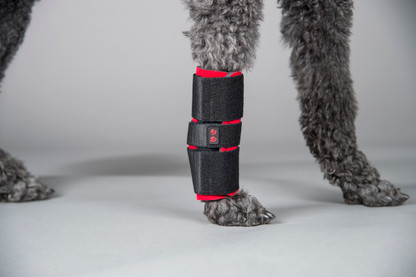09/11/2024
How to Tell if Your Dog is Hurt or Injured
As a devoted dog mom, it's natural to feel a wave of worry when your furry friend seems to be in pain. Our dogs are more than just pets; they’re family. They provide us with unconditional love, companionship, and joy, and the thought of them suffering can be heart-wrenching. But take a deep breath and know that there are steps you can take to help them feel better. One of the most common signs of injury in dogs is limping. Sometimes, these injuries are minor and heal on their own with time, while others may need a bit more attention and care. It's crucial to understand the signs, assess the situation, and know when it's time to call your trusted veterinarian.
Locating the Injury: Understanding Your Dog's Signals
When your dog is hurting, it can be challenging to figure out exactly where the pain is coming from. Dogs are incredibly resilient and often hide their pain as a natural instinct. However, there are some telltale signs to look for. Generally, when a dog has an injury, they will favor their healthy legs and avoid putting weight on the affected one. A quick tip is to watch your dog closely as they walk. If you notice your dog's head bobbing up when the sore leg touches the ground, it's likely they are trying to alleviate discomfort.
If the limping persists for more than a day or reoccurs frequently, it’s wise to schedule a visit to your veterinarian. Don’t ignore these signs; your fur baby relies on you to be their advocate.
Once you’ve identified which leg is affected, take some time to examine it gently. Start with an uninjured leg to see how your dog responds to pressure and touch. Then, move on to the injured leg, starting from the toes and slowly working your way up toward the body. Your calm demeanor and gentle hands will help comfort your dog during this process.
Checking for Common Issues: Nails, Paws, and Joints
When examining your dog's leg, start with the basics:
- Check the Toenails: Cracked or split nails can be incredibly painful, especially if the quick (the sensitive part inside the nail) is exposed. If you see any issues with the nails, it might be causing discomfort.
- Examine the Paws: Look at the pads and the webbing between the toes. Sharp objects, such as small stones or thorns, can easily get lodged here, causing pain with every step. Cuts, scrapes, or burns on the pads are also common culprits of limping.
- Inspect the Joints and Limbs: Swelling, tenderness, or an unusual range of motion can indicate a sprain, strain, or even a more serious injury. Gently move the leg and note if your dog winces or pulls away; this is a good indicator of discomfort.
Understanding what is causing your dog's pain is the first step in helping them heal. It's okay to feel unsure or worried—you're not alone in this. Remember that you are doing your best, and sometimes a professional opinion is needed to get the full picture.
Sprains and Strains: Common Yet Manageable Injuries
Sprains and strains are some of the most common injuries in dogs, and while they sound scary, they are often manageable with proper care. Sprains involve injuries to the ligaments that connect bones, often caused by jumping, falling, or even stepping into a hidden hole. They typically affect the wrists and knees. Strains, on the other hand, affect the tendons that connect muscles to bones and are often a result of a slip, fall, or sudden twist. These are most commonly seen in the hips and thighs.
Symptoms for both sprains and strains include limping, avoiding weight on a leg, or a leg that suddenly seems lame. As frightening as these signs can be, know that your dog can recover with the right care.
Treating Your Dog’s Leg Injuries: A Path to Recovery
The good news is that there are several ways to support your dog on their road to recovery. Rest is essential; it allows time for healing and helps prevent further injury. Keeping your dog calm and limiting their movement can be a challenge, especially if they're active or love to play, but remember, this is temporary and for their benefit.
For injuries that need a bit more support, physical therapy can be incredibly effective. Gentle exercises, guided by your veterinarian or a pet physical therapist, can help strengthen the muscles around the injury and promote healing.
Another valuable tool in your pet care arsenal is the use of a quality brace or support. Products like those offered by DogLeggs are designed to provide stability and comfort to the injured area, reducing pain and helping your dog feel secure as they heal. These braces are an excellent alternative to cumbersome bandages and are tailored to suit a range of conditions, from sprains to post-surgery recovery.
As always, it's essential to consult with your veterinarian when deciding the best course of treatment. They can offer a professional assessment and guide you toward the most effective solution for your beloved pet's needs.
A Message of Hope: You’re Not Alone in This Journey
Seeing your dog in pain can feel overwhelming, but remember that your love and care are powerful tools. Your dog looks to you for comfort, safety, and support, and by being proactive, you’re already making a difference. There is hope, and with a bit of patience and the right care, your furry friend will be back to their joyful, tail-wagging self in no time.
If you need more guidance or support, don't hesitate to reach out to professionals who understand what you're going through. At DogLeggs, we are committed to providing innovative products that support your pet's health and well-being. Our team is here to help you navigate this challenging time with compassion and expertise.
Your dog has been there for you through thick and thin, offering comfort, laughter, and love. Now, it’s your turn to be there for them—every step of the way.


